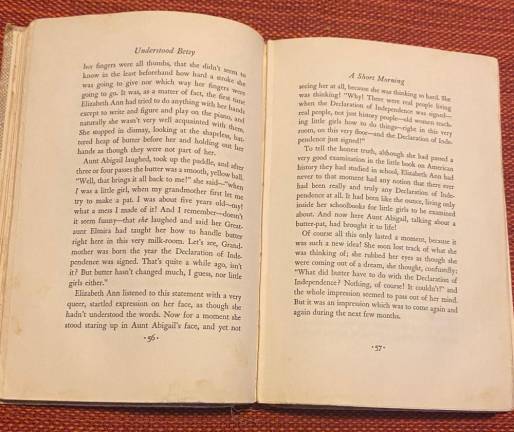The Book: My Favorite Childhood Stories

My husband, Tim, and I are almost finished unpacking our belongings after we moved. Memories of things past are contained in multiple cartons, and most boxes are labeled books in bold red or black markers. It’s autumn, and we just moved to a new apartment six blocks away, still in our familiar Upper West Side neighborhood, but with the New York City luxury of more space. After endless days of going through our belongings, we feel like tired, ancient dancers, stretching, bending, and moving. We try to be graceful but fatigue rules.
Tim’s robust earth-red bookshelves dominate our new living room with his grave books on politics and economics have somber blue and black covers.
I have my own collection of fiction, religion, poetry, psychology, and health. I hold each book with care, mindful of memories, an alphabet of days, weeks, and years.
“Mrs. Wiggs of the Cabbage Patch” by Alice Hegan Rice introduced me to poverty. This 1901 book was produced as a film in 1934. The old-fashioned images seemed relevant today. The setting was a down-and-out neighborhood in Louisville, Kentucky. Hard times were universal for this struggling, widowed matriarch and her large family. My mother read aloud this book to my brother and me, providing a source of wonder and enthusiasm. She conveyed the roles of all of the tale’s family. During these hard times, Jimmy, the oldest son, could only have one slice of bread. “Why can’t he have more?” I asked. I was nine.
My family lived in a comfortable house in an aspiring middle-class community with a narrow river in the backyard. My town had lush street names: Lotus Oval North, Riverdale Road, and Cloverfield Road. The blocks sounded so country-serene, but poverty was present too. Across the creek, as we always called it, sharecroppers who lived in cabins appeared then disappeared after a brief time. I was four years old when the small shacks and their occupants came and went to unknown destinations. My mother visited these abandoned cabins and was devastated about their dilapidated condition.
“Understood Betsy” by Dorothy Canfield Fisher showed the tension between Betsy, Midwestern city life and her later stay with her Vermont cousins. Betsy found it hard to master country ways but, in time, she appreciated her new community. This 1916 book offered insight into the complex nature of change, suitable for any time and any child. Betsy and her young friends provide help to a classmate whose father had a heavy drinking history
The 1930 book “Little Rag Doll” by Ethel Calvert Phillips was my mother’s book, and she gave it to me when I was six. I was her only daughter. We both loved this tale about Dilly, a doll treated cruelly, and her escape. She runs away with Mrs. Thimbletop, a wise fairy. Is it a metaphor for today’s domestic violence scenario? Dilly chose to claim a new future, and all readers rooted for Dilly’s freedom and better times.
My unpacking is almost done. Now I can explore my new world. Around the corner is Ballet Hispanico, with posters of athletic yet graceful men and women. Buoyant and bright school children are playing in the elementary school. Across the street is a community garden, with the quiet pleasure, the oasis of calm, the serenity of the green glory of plants and trees. Next to the park, Claremont Riding Academy once reigned with its regal horses and careful riders. I still visit my favorite café for my iced coffee.
The owner smiles and starts my morning begins with zest. This day begins with adventure. What events will highlight this recent season as the leaves’ colors change? Where can I find a new place for wonder? What can I write to signify my new day? What books will I discover and enjoy in my new home?